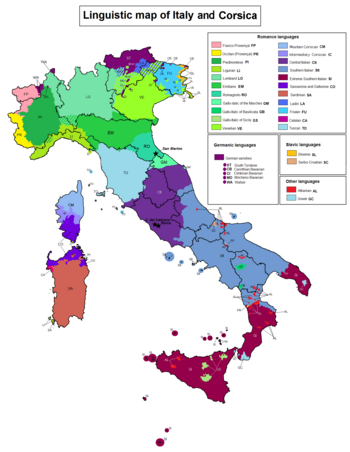Galloital
The Galloitalische or Gallo Italian (Italy. Galloitalico ) is a group of northern Italy dialects that the Piedmont , which Lombard , the Ligurian and Emilian - Romagna comprises. These are so linguistically different from Italian that they cannot be counted as dialects of this language. However, there is no umbrella language to which they could be assigned instead and no developed standard variety . Galloital has clear connections on the one hand to the Rhaeto-Romanic and on the other hand to the Gallo-Roman languages (i.e. French , Franco-Provencal and Occitan ). In addition, all Galloital dialects have a Celtic substrate .
Apart from the dialectal peculiarities, the following features can be found in all Gallo-Italian dialects:
phonetics
This is the presence of the sounds [ø] and [y], graphically mostly << ö >> and << ü >>, which can be traced back to Celtic substratum, also in French, cf. vulgarat. MURU "Mauer"> Piedmontese mür (cf. French mur [myr]).
- Sonorisation of intervocal Latin occlusive sounds
Latin -C-, -P-, -T- is sonorized, spirantized or can disappear completely. Example: vulgärlat. FRATELLU "Brother"> Lombard fra d el , Piedmontese frel (shrinkage). This phenomenon is common to all Western Romance languages , cf. french frère / Occitan fraire , but it does not appear in Eastern Romance : Italian fratello , Romanian. frate .
- Syllable structure consonant-vowel-consonant-vowel-consonant
All vowels except Latin -A fade in the final, which is why, in contrast to the southern Italian dialects, a syllable structure of the type CVCVC results.
All double consonants become simple ones, cf. lat. SPALLA "shoulder"> galloit. spala . This is a typical feature of the Western Romanic languages, but also of Romanian , while there are many Geminats in Sardinian, standard and southern Italian (hence standard Italian spalla , Sardinian spalla / spadda ).
- Certification for Latin CI-, CE-
While the word CENERE "ash" [kenere] was spoken in Latin, a palatalization took place in all Romance languages except Sardinian and Dalmatian . In standard Italian and Romanian the sound [tʃ] developed: ital. Cenere , rum. cenuşă . In Gallo-Italian, the sibilant / s / develops from this, hence CENERE> galloital. sener .
- Palatalization from Latin -CT-
Two phases of development: Piedmontese / kt /> / jt / (as in Portuguese) Lombard / kt /> / tʃ / (as in Spanish) cf. Latin LACTE (M) "Milk"> Piedmontese lait (cf. portug. leite ), Lombard lacc [latʃ] (cf. Spanish leche [letʃe]).
- Palatalization of stressed A (especially in the infinitive of the A conjugation)
So z. B. Latin CANTARE "to sing"> galloit. cantè / canter cf. also franz. chanter .
Morphology and syntax
The Gallo-Italian article from Latin ILLE is mostly el or il (phonetic often [əl]), in contrast to the southern Italian, where the article forms lu , o or ru (with Rhotazism ) have developed from ILLU . For the area of verbal morphology it should be noted that in the 2nd person singular the Latin final -S is often preserved in the present tense, cf. piedmont. t'as "you have" (as opposed to ital. tu hai ). Usually there are separate forms of questions such as cantes-tu " do you sing". Especially for the 2nd Ps. But also for the 3rd Ps. Sg. There is an unstressed and an accented subject pronoun, which sometimes even has to be used with a nominal subject, cf. el can a baula "The dog barks" (literally "The dog barks"), a phenomenon that is also typical of the Rhaeto-Romanic Friulian (Friulian il pari al cjante "The father sings" (literally "The father he sings") ). The synthetic perfect (the Italian passato remoto ) is no longer used.
Literature and Sources
- Geoffrey Hull. The Linguistic Unity of Northern Italy and Rhaetia: Historical Grammar of the Padanian Language. 2 vols. Sydney: Beta Crucis, 2017. ISBN 978-1-64007-053-0 ; ISBN 978-1-54987-998-2 .
- Corrado Grassi among others: Introduzione alla dialettologia italiana. Laterza, Rome 2003, ISBN 88-420-6918-3 .
- Giacomo Devoto, Gabriella Giacomelli: I dialetti delle regioni d'Italia. 3. Edition. Bompiani, Milan 2002, ISBN 88-452-5089-X .
- Carla Marcato: Dialetto, dialetti e italiano. il Mulino, Bologna 2002, ISBN 88-15-08750-8 .
- PE Guarnerio: Fonologia romanza. 2nd Edition. Hoepli, Milan 1978, ISBN 88-205-0143-0 .
Individual evidence
- ^ Georg Bossong : The Romance Languages. A comparative introduction. Buske, Hamburg 2008, ISBN 978-3-87548-518-9 , pp. 197-198.
